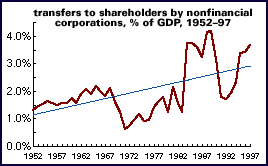
Home Mail Articles Stats/current Supplements Subscriptions Links
As was pointed out in the item "Juicy cash flow," one good explanation of the rises and falls in the stock market is the course of "free cash flow" (FCF). Though definitions vary, the underlying concept behind FCF is the difference between corporate profits and investments. So when corporations spend less on investment than they earn in profits, FCF is positive; when their capital expenditures exceed profits, FCF is negative (meaning they dip into their savings or turn to outside finance).
The chart nearby uses the Fed's flow of funds statistics to illuminate this relation. (The flow of funds accounts deal with financial activity in a way similar to the way the national income accounts - GDP and its components - deal with production and income.) Free cash flow is defined as after tax profits less capital expenditures; the measure for the stock market is the Standard & Poor's 500. The lines in the chart represent the yearly change in each measure (not adjusted for inflation).

Note that FCF tends to lead the stock market. It may be that FCF simply represents a lagged response to the business cycle: as profits rise, firms boost their investments with a bit of a delay, since it takes time to notice the change and make the investments (or vice versa, when profits fall). Along these lines, then, the stock market could just be mirroring these trends, with yet another delay. But it's interesing that the stock market seems to follow, not lead, the real world - a blow to those who attribute it great powers of clarification, even prescience.
There's also a longer-term trend at work, mentioned in the
original LBO article: an increasing tendency for corporations
to transfer surplus funds to shareholders. Firms have been paying
dividends to shareholders since time immemorial.  But
over the last 15 years, they've also been retiring lots of stock
- over $800 billion of it since the early 1980s - when they buy
each other in mergers, or buy their own shares to boost their
prices. So, instead of nonfinancial firms floating new shares
to raise capital, making them net sellers in the flow of funds
accounts, they've been net buyers, making them net buyers. If
we combine dividends and net stock offerings/retirements, we get
a measure we might call transfers to shareholders. That measure,
expressed as a share of GDP, is charted nearby. So one of the
major reasons for the great bull market is that companies have
been shoveling money into their shareholders' pockets.
But
over the last 15 years, they've also been retiring lots of stock
- over $800 billion of it since the early 1980s - when they buy
each other in mergers, or buy their own shares to boost their
prices. So, instead of nonfinancial firms floating new shares
to raise capital, making them net sellers in the flow of funds
accounts, they've been net buyers, making them net buyers. If
we combine dividends and net stock offerings/retirements, we get
a measure we might call transfers to shareholders. That measure,
expressed as a share of GDP, is charted nearby. So one of the
major reasons for the great bull market is that companies have
been shoveling money into their shareholders' pockets.
For more, see Doug Henwood's Wall Street, and LBO #79.
© Copyright 1997, Left Business Observer. All rights reserved.
Home Mail Articles Stats/current Supplements Subscriptions Links